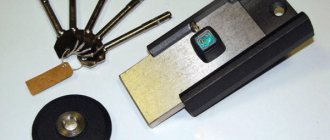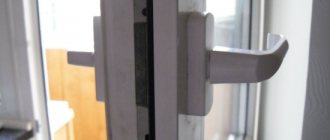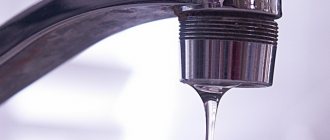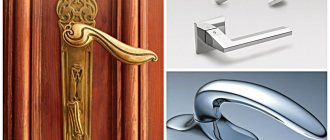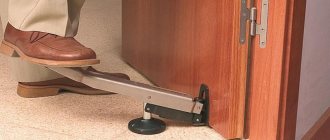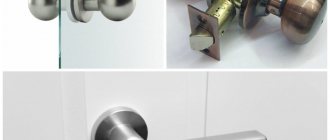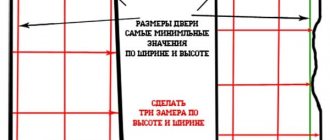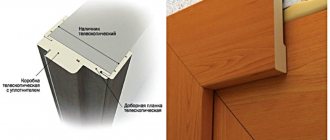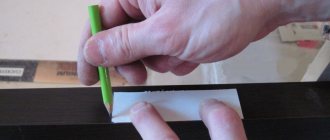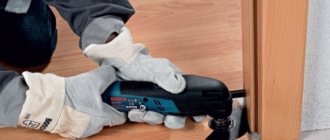Photo from the site replacement-installation-repair-locks.rf Surely each of you has encountered a broken door handle in your apartment. The problem is quite common, and the reason for this can be either poor quality assembly of the manufacturer or the design of the mechanism itself, which tends to fail over time. If you bought the accessories recently and still have warranty receipts, the store will replace your faulty device with a new one. And if the handle breaks, which has served you faithfully for several years, do not rush to run to the store for a new one. In this article we will tell you in detail and describe how to repair an interior door handle.
Types of handles and causes of breakdowns
According to their design features, handles are divided into 3 main classes - push or lever, push-button and stationary.
- Push ones are activated by moving the handle in a vertical plane. In order for the lock to slam shut, you just need to release the handle.
- Push-button - a type of push-button. Only here the handle is made in the form of a ball. To open or close a door equipped with such a system, you do not need to make any special effort. It is enough to turn the ball and return it to its original position.
- Stationary ones are intended only for swinging open the door structure and are not connected to a locking mechanism. These handles are static and cannot be turned or lowered.
There are several options for door handles. According to this parameter, handles are distinguished:
- Staples . Characterized by reliability and simplicity. Used solo, without a locking device. They are easy to install and such accessories last a very long time.
- Latches . The canvas is securely fixed when closed. They can come complete with different locks: halyard, magnetic, roller.
- Buttons . Made in two versions to choose from - singles and doubles. Accordingly, they are mounted either on only one side of the door, or on both.
- With lock . Blocking access to the premises. Installed in the bath, toilet or bedroom.
- Barbells . The door opens easily. Allows you to quickly enter or leave the room.
- For sliding structures . They are fixed flush with the door leaf together with a latch, escutcheon or retainer.
Each type of door handle has its own causes of breakdowns. However, the most common of them are violation of operating conditions, purchase of low-quality cheap products, and excessive physical exertion. In a number of situations, the door handle has simply exhausted its performance resource. In this case, the mechanism must be replaced.
Attention ! If the violations are incompatible with further functioning, the handle must be permanently replaced.
Door handle device
To simplify your acquaintance with the mechanism of the device, let's look at what types of handles are on the market:
- Rotary. These are one of the most popular devices for installation in doors inside an apartment. These types of handles are usually round and have a keyhole in the middle. To open the door, simply turn such a device clockwise. If your door handle opens counterclockwise, it may not be installed correctly.
Photo from remontistroyka.org
- Push. Unlike rotary devices, devices of this type are equipped with a lever. To activate the device, simply press the handle down.
- Fixed. Models of this type have been used extremely rarely recently. They do not have a locking mechanism and are quite easy to install. They are either attached to a rod and screwed on both sides, or fixed with screws.
Photo from the site GoldDveri.ru
Photo from the website HappyModern.RU
The next step in order to understand how to repair an interior door handle is the design of the device.
Let's look at the mechanisms that make up a door handle:
- Lock. A mechanism located inside the unit. The main element of the lock is the bolt. She is the one who keeps the door closed.
- Square clamp. This mechanism is brought out and connected to the internal part, thereby putting it into action.
- Lever. External part of the device. It is the handle that you pull or turn to open/close the door.
- Overlay. It is used as a decorative element and also covers all mechanisms and fastenings.
- Response element. This part is located inside the door handle box. At its core, it is a plate that covers the gap in the frame where the valve fits.
Components of the mechanism
As the proverb says: “If you don’t know the ford, don’t go into the water.” The same goes for door handles. To be able to repair any of them yourself, you need to have an understanding of its structure. Standard pressure ones consist of the following parts:
- the handle itself;
- latch;
- strip, socket;
- flange;
- removable key;
- core;
- fastening elements.
The set with a handle equipped with a lock includes a cylinder and several spare keys in case they are lost or damaged.
The door design of the knob type consists of an internal rotary handle, a technological hole, a spring clip, and a lock button. In addition, there is a functional shank, a decorative flange, a mounting plate, a locking mechanism cylinder, and an external rotary handle. Don’t forget about the latch mechanism, the plate located at the end of the door and the strike plate for the door frame.
Important ! Due to incompetence in the design of the door handle mechanism, 90% of fatal breakdowns occur. Subsequently, the structure can no longer be restored.
Types of springs
A spring is an element of a mechanism that, due to deformation, temporarily accumulates mechanical energy for its subsequent release. A simple spring is a smoothly curved metal wire or strip.
Springs can be screw (cylinder-shaped) or spiral (flat-shaped).
The mechanisms use conical (for shock absorbers), plate (for springs), disc and other types. Some devices replace metal with gas or liquid.
These elements operate through compression, tension, torsion and bending. They can have constant and variable hardness. To attach to other parts of the mechanism, the ends are bent in the form of loops or at right angles to form a stop.
Devices are used in a variety of mechanisms that require moving elements without a drive. In particular, these parts are inserted into locks with a metal handle lever.
The return spring for door handles is a spiral type that accumulates energy through compression and releases it when returning to its original shape. It is also called a “snail” because of its external resemblance to a mollusk shell.
Step-by-step repair: instructions
Since the general structure of door handles has a number of similar points, the main sequence for repairs has common features.
- The first thing that technicians advise you to pay attention to when a door handle breaks is the lack of lubrication. Oddly enough, the lion's share of problems with pens occurs precisely for this reason.
- You also need to check how well the screws are secured. If they become loose, you need to take a screwdriver and fix the parts properly. This will return the parts to their original position and the problem will be resolved.
- It happens that the handle falls away from the canvas, although the base remains in place. Here you need to understand that the retaining ring has burst. Installing a new one is not difficult, but it will take a considerable amount of time. First you need to dismantle the remaining part of the handle, and then check the condition of the ring. If it still falls apart, they buy another one and install it in the place of the previous one. When the square cover is destroyed, there is only one verdict. Complete replacement of the device, because it is impossible to fix it.
However, if, after a thorough inspection, other reasons for the door handle failure are discovered, it is recommended to follow the generally accepted procedure:
- Remove the decorative trims located directly under the handle.
- Unscrew the bolts and carefully remove the door handle itself.
- Carefully examine the condition of the internal mechanism parts.
- Pay attention to the key washer and torsion spring.
- Release the washer from the retaining rings.
- Check the condition and location of the spring.
When even such a thorough examination did not give the desired answer to the question about the origins of the problem, one thing remains. Unscrew the plate from the end of the door and completely remove the mechanism hidden under it. Once broken parts are identified, they should be replaced with new ones. Then reassemble the handle.
Attention ! In order not to get confused when dismantling the door handle, it is better to lay out the parts in the order in which they were removed from the canvas.
Most common problems
Unfortunately, any mechanism that can be subjected to such intense influence as an interior door handle sooner or later requires repair. This can be corrected either with the most banal movements or by completely replacing the worn element.
It is not always possible to notice a problem in time, since some of them are so insignificant that people simply do not attach importance to them. Nevertheless, it is precisely because of this attitude that one often has to spend money on repairs and replacement of fittings.
The most common problems with door handles are the following situations:
- The handle gets stuck. When you press the lever, you feel resistance, and in order to move it you need to make an effort and perform additional manipulations such as twitching.
- The latch is stuck . This applies to structures with a lock. In this case, the movement of the crossbars becomes difficult both when closing and opening the door.
- Looseness. The handle moves away from the canvas, wobbles and sags. The entire locking mechanism may become loose.
- The handle does not return to its original position . In this case, when you press the handle, it does not immediately return to its original position, although ideally it should instantly spring back. In this case, such a defect can be observed both in relation to the lever itself, and in combination with the latch.
- The tongue does not move . When you press the handle, the mechanism does not work; the halyard tongue either does not hide, or falls down and does not stick out back.
To fix a faulty door handle, you need to determine the exact problem
If there is resistance when pressing the handle
If, when trying to move the door handle to the open position, your hand feels resistance, this can only mean one thing.
Moisture and dust that penetrated the door handle structure made the lubricant solid and unsuitable for further service. For this reason, the components are subject to friction and are no longer able to move as smoothly as before. Very often, to cope with a problem, you do not need to remove the handle . To do this, you need to lubricate the bolt and turn the door handle several times. This way the lubricant can be evenly distributed throughout all parts and eliminate the problem.
If the superficial maintenance option does not have the desired effect, it is worth resorting to complete dismantling of the structure, its disassembly and step-by-step treatment of all structural elements with lubricants.
Healthy ! Untimely maintenance of the moving parts of the door structure eventually leads to final failure and the need for replacement. And these are considerable financial costs.
Part design
Handles come in different designs, but the components have much in common. Some have nothing to do with the lock; repair is then impractical; it’s easier to completely replace it.
Interior door handles with a built-in lock can be turned or pressed; they can be used to block the entrance to the room from the back side.
Essential elements:
- holder or handle;
- lock mechanism with tongue or bolt;
- the lock and the handle are connected by a square pin;
- a strip covering the fasteners to the door;
- a spring, due to which, after pressing, the handle returns to its normal position;
- a limiter that prevents the handle from turning around its axis;
- special rings.
All elements are easily replaceable; they can be purchased at a specialized store and the handle can be repaired.
If the door handle does not immediately return to its original position
When the handle gets stuck in the lower position and does not spring up, there are several possible scenarios:
- The return spring has slipped . It is recommended to put the detached part back in place as quickly as possible. This is done in exactly the same way as in the case of replacing the retaining ring.
- The edges of the snail are bent . If weakened, it is necessary to dismantle it and purchase a working version.
- The snail is broken . It is necessary to remove the remaining parts. Select an element with similar parameters. Replace the snail mechanism with a new one.
Then you should fix the spring, return all the parts to their designated places and be sure to check their functionality. The final step is to install the door hardware and secure it properly. Knowing these nuances, even a completely green technician can handle an ordinary breakdown.
At the same time, you won’t have to involve someone from outside and overpay for something that you can resuscitate with your own hands.
How to replace?
Anyone can carry out the replacement independently, without the involvement of a specialist. If you do not plan to change the interior, but are satisfied with the shape of the handle, then you can purchase a similar one to make work easier.
Remove the old one with a screwdriver. Having removed the lever itself, you need to get the mechanism.
Having completed these simple steps, proceed to installing a new one: you need to disassemble it, and if that doesn’t work, then you should look at the instructions:
- First, the tongue is attached: it needs to be installed and secured with self-tapping screws. It is better to use a screwdriver, then it will be easier for the technician to adjust the direction and force of pressure.
- Then install the handle itself, making sure that the decorative trim completely covers the hole. In order for the handle to fit correctly, you can tighten the bolts not completely, correct the position of the lever and secure it completely.
- Then install the trim.
When using cheap products, their mechanical core is made of inexpensive soft materials, which, when installed, warp and begin to jam. In this situation, you can slightly loosen the lag bolts.
Prevention of breakdowns
Prevention is the best tactic in an effort to save your nerves and family budget. It is much easier to take proactive action from time to time than to throw away large sums of money every time. In order to avoid systematic breakdowns of door handle mechanisms, there are basic rules of reasonable behavior:
- Timely maintenance . It is not at all difficult to establish a specific service schedule for door handles. It takes little time, but the benefits are enormous.
- Miser pays twice . Cheapness is a way to create a huge number of financial problems later. The choice should be made in favor of quality rather than a dubious discount.
- We operate correctly . The product must be handled carefully. Protect from sudden mechanical and thermal influences. Remove scratches and chips as they appear.
- We notice warning signs . As soon as there are suspicions of deviations in the operation of one or another mechanism, action must be taken immediately. Do not wait for consequences that cannot be corrected.
Thanks to simple steps, it is not difficult to keep your door handles in working condition. Thereby extending the life of the structure for many, many years.
Summarizing all of the above, one cannot help but note the fact that repairing a door handle of any design will not be difficult. In order for the process to be crowned with success, a simple amount of basic knowledge about the structure of various types of mechanisms is sufficient. However, if you also know how to prevent breakdowns, you can minimize repair work, avoiding expensive purchases and wasteful expenses.
